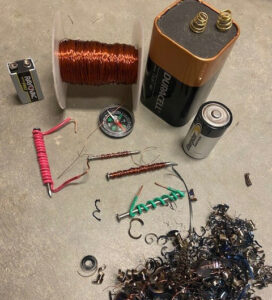50 Circuits
Circuits are used to deliver energy to a load—from a small device to a household appliance to an industrial motor. Loads often carry a nameplate that identifies their standard electrical reference values, including voltage and current. In place of a nameplate, some manufacturers provide a detailed schematic (technical diagram) of a load’s circuitry. Manuals may include standard values.
These numbers tell a technician what readings to expect when a load is operating normally. A reading on a digital multimeter can objectively identify deviations from the norm. Even so, the technician must use knowledge and experience to determine the factors causing such variances.

Create an Electro Magnet
Materials: 6V battery, copper wire, 2 alligator clips, and a large nail
Wrap the middle of the wire around the nail, then attach an end to each of the battery terminals with your alligator clips. The nail will attract paper clips and other small ferromagnetic objects. Experiment and see how the number of times you wrap the wire around the nail effects the strength of its magnetic qualities.

